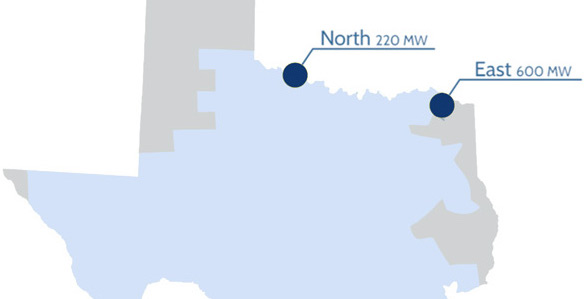By Tom Kleckner
AUSTIN, Texas — Despite opposition from independent generators and competitive retailers, ERCOT stakeholders last week approved a protocol change that clarifies that the ISO can curtail DC tie loads without having to declare an emergency condition.
The Technical Advisory Committee on Thursday approved a nodal protocol revision request (NPRR818) that specifies that ERCOT may curtail DC tie loads during a watch, before declaring an emergency condition.
Representatives from two independent generators (Luminant and Dynegy) and three competitive retailers (Direct Energy, Just Energy and Reliant Energy Retail Services) abstained from the vote but made their opposition known.
Luminant’s Amanda Frazier said she was concerned about the way in which the NPRR was developed. It was written after ERCOT operators issued a power operations bulletin (POB) on Sept. 28 that changed the ISO’s operation of its five DC ties, which have a capacity of more than 1,250 MW. The POB, which took effect two days after its issuance, particularly affected exports into Mexico over Comision Federal de Electricidad ties.
Unilateral Action
“ERCOT has been curtailing DC ties in emergency situations. Then they unilaterally decided to stop doing that — and did that by issuing a [POB], a process not reviewable by stakeholders,” Frazier said. “That materially changed market outcomes for those market participants using DC ties into Mexico. I find that problematic. I think if something needs to be changed in the protocols that has major market impacts, we should know about it. We should be able to look at it, and we should know the policy decisions behind it.”
Luminant’s written comments recommended ERCOT only curtail DC ties during a Level 2 energy emergency alert (EEA), and not during a watch. It pointed out that voluntary load curtailment is not fully deployed until the ISO declares a Level 2 EEA. Involuntary load shed should not be used ahead of other “compensated, voluntary reliability deployments,” the company said.
‘Future Fix’
“I understand that wouldn’t work in a localized problem, but this language [isn’t limited to] a localized emergency,” Frazier said, “I don’t think it’s … appropriate to curtail DC ties before an EEA2 for a systemwide emergency, but I understand that’s going to be looked at in a future fix to this.”
Shams Siddiqi, representing Rainbow Energy Marketing Corp., the NPRR’s sponsor, told the TAC that “future fix” will be an additional protocol change.
Reliant Energy’s Bill Barnes said he would not oppose the NPRR given that additional revisions would be filed. He said that would fix “the problem we see: loosening reliability actions to allow these DC ties to be curtailed sooner, which has market impacts.”
“I think the ops team took what they viewed as appropriate actions, considering some of the changes that occurred,” ERCOT COO Cheryl Mele told the TAC, referring to the issuance of the POB. “The question I’m hearing is POBs with such a significant impact shouldn’t come out [two days] before we implement it. I concur with that. We should use the proper forums and processes.”
Mele’s comments related to recent changes in ERCOT’s capacity, including the Frontera Plant’s move from ERCOT to Mexico, and an increase in DC tie capacity, ERCOT spokeswoman Robbie Searcy said after the meeting. (See ERCOT Board OKs Rio Grande Valley Fixes.)
‘Fair Request’
Garland Power & Light’s Dan Bailey asked ERCOT to report back to the committee on how often curtailments are made during watch events.
“That is a fair request,” Mele responded. She said the reports will be filed with the TAC’s Reliability and Operations Subcommittee, “so you guys will be engaged.”
Rainbow Energy contended the NPRR would “minimize inefficient wholesale market operations and consequent harm to market participants.” The revision would be effective April 5, assuming ERCOT’s Board of Directors approves it the day before.
Before ERCOT issued the operations bulletin, it would accept DC tie e-Tags up to the physical limit of the ties, rarely curtailing the tags close to the operating hour.
Under the POB, e-Tags have been denied when day-ahead prices were relatively high while real-time prices were depressed and DC tie capacity was under-utilized, according to Siddiqi’s “business case” for the change. The result: “an avoidable inefficient outcome for the market and loss for the market participant,” Siddiqi said.
Siddiqi also said ERCOT prefers to take action in advance to avoid the chance of an emergency condition “and subsequent [NERC] scrutiny of why ERCOT did not act in advance to avoid the emergency.”
“Market participants wanting to export power have to procure power in the day-ahead market without knowing whether the e-Tag will be approved or denied,” according to the NPRR. “In turn, they are subjected to a loss and contractual difficulties with their counterparties if the e-Tag is denied.”
By allowing e-Tags to be curtailed in a watch before an EEA2, “ERCOT can revert back to its pre-POB operating procedure of approving e-Tags up to the physical limits of the DC ties,” Siddiqi said. “E-Tag approval can again be done prior to DAM [the day-ahead market] — allowing market participants to correspondingly procure energy in DAM and have the added certainty in its contractual obligations.”
“We have worked with Rainbow to implement what we understand the stakeholder’s intent, so we can be very transparent in the future,” said ERCOT’s Dan Woodfin, senior director of system operations. “The protocols don’t affect how we set limits today. With this change, how we set those limits will be clarified.”





